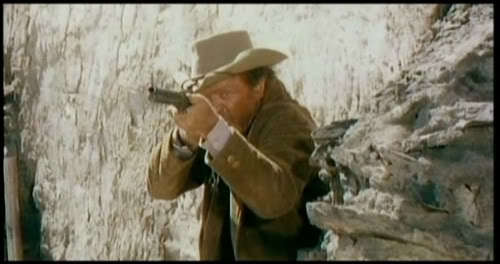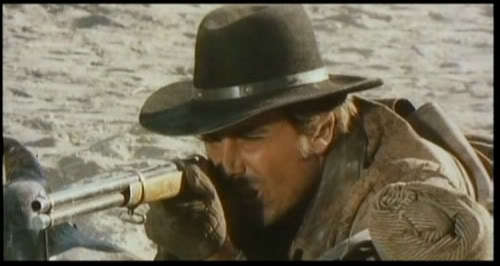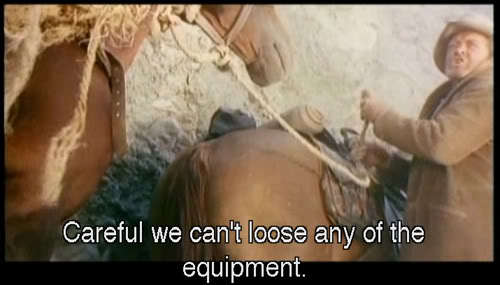OK, I have copied the entire entry from the Dizzionario and post it below for an italian speaker to translate for us.
I apologise in advance for a lack of accents (I just can’t figure out how to get them in my text) and for any other glaring errors in transposing. Hopefully this will help add more info to this thread.
Warning: It is a long entry!!
Ognuno Per Se, 1967 (uscito nel 1968)
Il miglior film di Giorgio Capitani, specializzato in commedie leggere e poi in lunghe serie televisive di successo, e ottimo western barocco completamente construito da Di Leo in sceneggiatura sulla falsariga di film come Il Tesoro della Sierra Madre. In un primo tempo il regista doveva essere Lucio Fulci e infatti l’atmosfera e simile a Tempo di Massacro, scritto da Di Leo per Fulci. Sembra che Pugliese ed Ercoli non si fossero messi d’accordo con il regista per questioni economiche e di tempi. Cosi si chiamo Capitani, contro la volonta di Di Leo. Al centro della storia, vagamente ripresa da quella del Tesoro Della Sierra Madre di John Huston (e dal romanzo di B. Traven), c’e un carico d’oro che il vecchio Van Heflin, qui ancora bravissimo, ha trovato con le sue mani. Per portarlo in citta si fa aiutare dal figlioccio George Hilton, perfetto in ruolo di debole un po’ gay, e dal suo luciferino amico Klaus Kinski, in una delle sue prove western migliori in assoluto. A loro aggiungiamo il vecchio amico Gilbert Roland, dandy con il perenne sorriso e il baffetto. Questo cast perfetto e altamente funzionante per merito di Capitani, dara vita a una lotta psicologica che alla fine portera alla distruzione di ogni rapport e a una serie di duelli mortali.
Di Leo lo ricordava come uno dei suoi migliori copioni western: <<Giorgio Capitani, per quanto fosse incapace di fare il western, aveva tra le mani una sceneggiatura talmente bella…E li incominciai a ficcare elementi di psicanalisi, odio tra fratelli… insomma cercai di imbottirlo un po’ culturalmente>> (<>). Nelle intenzioni di Di Leo si sarebbe dovuto chiamare Ognuno Per Se (e Dio per Nessuno). Anche se non sappiamo come Di Leo lo avrebbe diretto, va ditto che la regia di Capitani era notevole, e lui stesso lo ricorda come il suo film preferito. Secondo Augusto Caminito, che scrisse il film con Di Leo e non rammenta Fulci come il primo regista indicato dalla produzione, fu invece Capitani a essere scelto da Ercoli e Pugliese all’inizio del progetto. <<Il film venne scritto per lui, ricordo che incombeva su di noi durante la stesura della sceneggiatura.>> Di Leo era insofferente verso tutti i registi dei film che scriveva, <<in fondo li disprezzava tutti. Ma aveva le sue idée e quando non condivideva quelle degli altri, rimaneva zitto.>> (Caminito)
Anche George Hilton ne parla ancora con grande piacere, anche perche ha potuto lavorare con Van Heflin, un attore che gli ha insegnato moltissimo. <<Peccato che nel montaggio hanno tagliato una sequenza molto drammatica in cui lui (Kinski) mi bruciava il braccio con una sigaretta. Fu censurata.>> (<>). Sergio D’Offizi, direttore della fotografia, ricorda che entro nel film grazie e Ercoli e Pugliese, coi quail aveva fatto un paio di western con Giuliano Gemma. <<Con Giorgio Capitani ci siamo trovati abbastanza bene, tecnicamente sapeva quell ache voleva. Avevafatto l’aiuto per molti anni. Non era uno inventato. Stavamo sulla stessa lunghezza d’onda. Il cast era stupendo. Van Heflin, Gilbert Roland, Klaus Kinski, degno di un film di serie A. Va ditto che Van Heflin con Giorgio non si prendevano tanto. Era anche un grosso bevitore e, quando non stave tanto in se, poteva creare problem. Ebbi delle buone critiche, una anche sul “Messaggero”, dove parlavano della mia fotografia.>>
Marcelo Crescenzi, aiuto regista, ricorda bene la lavorazione in Almeria e tutto il cast. <<Van Heflin bastava che stave a posto con la parrucchetta e che aveva il bicchiere di bourbon sempre pieno, ma non ha mai dato problem. Gilbert Roland era un simpaticone, pazzo per il peperoncino. Si era fatto portare la sua vecchia Rolls near con autista cino-americano per farsi accompagnare da lui sui set. Kinski non era ancora come lo abbiamo visto dopo, quseto era uno dei suoi primi film italiani. Ma una note lo hanno arrestato visto che si era messo in mezzo alla camionale con un candelabro acceso in mano.>>
Notevolissimi anche Rick Boyd e Sergio Doria come i due corvi. Faranno una pessima fine. Sarah Ross e in realta l’attrice dell’Est Sonia Romanoff. In un numero dell’<> del 1967 si fa chiamare Sonja Ross e si esibisce in una foto un po’ ose. Spettacolare la musica da grand guignol di Carlo Rustichelli. Esterni in Almeria, Guadix, Granada e Sierra Nevada. Ottima la critica attuale. Carlos Aguilar lo ritiene <<uno dei piu originali e interessanti western europei, construito a partire dale relazioni, veramente ben scritte, che si instaurano tra i protagonisti>>.
Frase di lancio: <>. Girato nel 1966 anche negli studi Balcazar.


